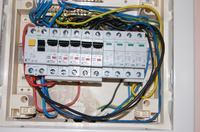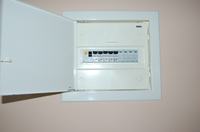Hello
This is my first post on this forum, so I`d like to say hello.
I have a fairly new electrical installation (building from 2000). One differential for the entire circuit (25A 30mA) and 5 circuit breakers. The problem is that if I test the differential with the test button, which disconnects the entire circuit and then turns it on, it blows out the socket fuse (16A), and what`s worse, it often blows out the meter fuse (20A) at the same time. . This also happened when my wife was using the iron, it sometimes blew two fuses at the same time: the one at home and the one at the meter. At first I thought it was the fault of the fuse in the house (there was a 10A fuse installed there, so I replaced it with a 16A one). It seemed a bit strange to me that someone installed 10A sockets on the circuit. I checked in the switchboard that the thickness of the wires is the same everywhere, so there shouldn`t be a problem). All elements in the switchgear are new, I replaced them a month ago (mooeler). The problem also existed before the replacement. Please help me solve the problem
Regards
This is my first post on this forum, so I`d like to say hello.
I have a fairly new electrical installation (building from 2000). One differential for the entire circuit (25A 30mA) and 5 circuit breakers. The problem is that if I test the differential with the test button, which disconnects the entire circuit and then turns it on, it blows out the socket fuse (16A), and what`s worse, it often blows out the meter fuse (20A) at the same time. . This also happened when my wife was using the iron, it sometimes blew two fuses at the same time: the one at home and the one at the meter. At first I thought it was the fault of the fuse in the house (there was a 10A fuse installed there, so I replaced it with a 16A one). It seemed a bit strange to me that someone installed 10A sockets on the circuit. I checked in the switchboard that the thickness of the wires is the same everywhere, so there shouldn`t be a problem). All elements in the switchgear are new, I replaced them a month ago (mooeler). The problem also existed before the replacement. Please help me solve the problem
Regards






